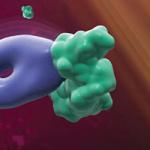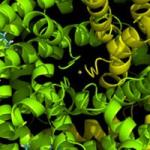
Kenneth A. Jacobson, Ph.D.
Senior Investigator
Molecular Recognition Section, Laboratory of Bioorganic Chemistry
NIDDK
Research Topics
Research Goal
Our overall goals are to design, chemically synthesize, and characterize pharmacologically new agonists and antagonists for the four subtypes of adenosine receptors (ARs) and eight subtypes of P2Y receptors and to explore their potential for treating human disease conditions.
Current Research
I am a medicinal chemist with interests in the structure and pharmacology of receptors and in developing drugs that act as agonists or antagonists of G protein-coupled receptors (GPCRs). My current focus is on receptors for purines, encompassing both adenosine receptors and P2 receptors, which are activated by ATP, UTP and other extracellular nucleotides. My lab has taken an interdisciplinary approach to studying the chemical and biological aspects of these receptors. We have used convergent modeling, mutagenesis and structure activity approaches to gather information about the three-dimensional structure of the receptors and its relationship to binding and activation functions. The determination of the X-ray crystallographic structures of the P2Y1 receptor and an agonist bound A2A adenosine receptor by our lab in collaboration with Ray Stevens of Scripps Research Institute is providing a new path to designing drugs that act at these receptors. We have developed a functionalized congener approach to drug design that permits inclusion of reporter groups such as fluorophores. Novel ligands (small molecules) for these receptors are developed using classical synthetic approaches and also by semirational methods based on molecular modeling and template design. Receptors are computer-modeled by homology to GPCRs of known structure, and the models for ligand recognition are tested and refined using site-directed mutagenesis of the receptor proteins. Recently, the involvement of extracellular loops of GPCRs have been implicated in the receptor binding of small molecules. We are interested in correlating structure of receptors and small molecular drugs with pharmacological properties.
Substances developed as potent and selective agents acting through adenosine and P2 receptors have proven useful as pharmacological probes and have potential for treating diseases of the central nervous system, immune system, and cardiovascular system. Recent accomplishments include the design and synthesis of the highly potent and selective A3 adenosine receptor agonists and antagonists, using a combination of library screening and optimization of known adenosine receptor ligands. These substances have been shown to be effective in models of treatment for glaucoma, cancer, stroke, and cardiac ischemia. Two selective A3 adenosine receptor agonists developed in our laboratory are currently in clinical trials for hepatocellular carcinoma, glaucoma, psoriasis, and rheumatoid arthritis. We recently published in collaboration with Daniela Salvemini of St. Louis University the protective effect of A3 agonists in animal models of neuropathic pain. This condition can accompany treatment with cancer chemotherapeutic drugs. Thus, A3 agonists could potentially reduce this side effect and allow the life-saving anti-cancer treatment to continue. We have discovered highly specific A3 agonists that reduce neuropathic pain in the mouse and rat and prevent its development. We recently found an A1 adenosine receptor agonist that has antiseizure effects in mice without some of the side effects associated with such agonists in the past. We have synthesized the first P2Y1 receptor-selective antagonists through functionalization of adenine nucleotides. The antagonists were optimized with the aid of receptor homology modeling. These substances have been shown to be effective in models of anti-thrombotic treatment, due to blockade of the proaggregatory effects of ADP. The pharmacological probes designed in our section have been used to demonstrate the connection between purine receptors and apoptosis (programmed cell death). A3 adenosine receptor agonists at low concentrations and P2Y6 receptor agonists have antiapoptotic effects. Furthermore, P2Y6 agonists promote insulin release in pancreatic islet cells. We are currently exploring the role of various P2Y receptors in the mouse.
Another potential method of using the protective effects of AR activation has been achieved through receptor engineering. Constitutively active mutant A3 adenosine receptors, in principle, could be delivered by tissue-targeted vectors for gene therapy. In addition, we have introduced the approach of neoceptors, also intended for eventual use in gene therapy, in which the putative agonist binding site is redesigned to accept only agonist molecules altered in a complementary fashion. Insight into the recognition of agonists by the receptors may be gained using site-directed mutagenesis and molecular modeling. We are exploring this approach conceptually with tailor-made agonist ligands (“neoligands”) that are selective for the neoceptor and not the native receptor, in combination with receptor mutagenesis. The neoceptor concept has so far been applied to A1, A2A and A3 adenosine receptors.
Applying our Research
Our selective receptor ligands are used as pharmacological probes of the role of extracellular nucleosides and nucleotides in the brain and in peripheral tissues. More than 50 compounds from our lab are available commercially as research tools and are used to advance research in hundreds of laboratories (PDF, 270.32 KB) . Our own internal studies and outside collaborations include studies of the role of these receptors, and possible treatments for, thrombosis, Parkinson’s disease, inflammatory diseases, cancer, diabetes, chronic neuropathic pain, and epilepsy.
Need for Further Study
The relationship between drug structure and biological activity requires further probing. The study of GPCRs, including purinergic receptors, provide promising avenues for the development of new drug therapy for treating chronic diseases.
Biography
- Bantrel Fellow, Weizmann Institute of Science, Department of Organic Chemistry, 1983
- Ph.D., University of California, San Diego, 1981
- M.S., University of California, San Diego, 1978
- B.A., Reed College, 1975
Selected Publications
- Srivastava DK, Navratna V, Tosh DK, Chinn A, Sk MF, Tajkhorshid E, Jacobson KA, Gouaux E. Structure of the human dopamine transporter and mechanisms of inhibition. Nature. 2024.
- Pradhan B, Pavan M, Fisher CL, Salmaso V, Wan TC, Keyes RF, Rollison N, Suresh RR, Kumar TS, Gao ZG, Smith BC, Auchampach JA, Jacobson KA. Lipid Trolling to Optimize A(3) Adenosine Receptor-Positive Allosteric Modulators (PAMs). J Med Chem. 2024;67(14):12221-12247.
- Wen Z, Pramanik A, Lewicki SA, Jung YH, Gao ZG, Randle JCR, Cronin C, Chen Z, Giancotti LA, Whitehead GS, Liang BT, Breton S, Salvemini D, Cook DN, Jacobson KA. Alicyclic Ring Size Variation of 4-Phenyl-2-naphthoic Acid Derivatives as P2Y(14) Receptor Antagonists. J Med Chem. 2023;66(13):9076-9094.
- Tosh DK, Pavan M, Cronin C, Pottie E, Wan TC, Chen E, Lewicki SA, Campbell RG, Gao ZG, Auchampach JA, Stove CP, Liang BT, Jacobson KA. 2-Substituted (N)-Methanocarba A(3) Adenosine Receptor Agonists: In Silico, In Vitro, and In Vivo Characterization. ACS Pharmacol Transl Sci. 2024;7(7):2154-2173.
- Jain S, Pydi SP, Jung YH, Scortichini M, Kesner EL, Karcz TP, Cook DN, Gavrilova O, Wess J, Jacobson KA. Adipocyte P2Y14 receptors play a key role in regulating whole-body glucose and lipid homeostasis. JCI Insight. 2021;6(10).
Related Scientific Focus Areas


Molecular Biology and Biochemistry
View additional Principal Investigators in Molecular Biology and Biochemistry


This page was last updated on Thursday, August 7, 2025